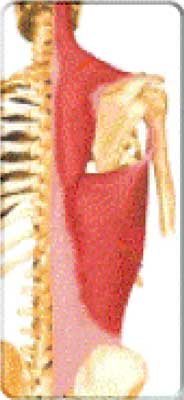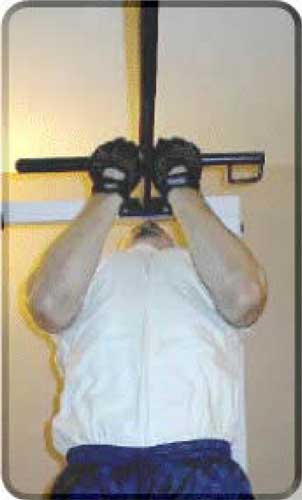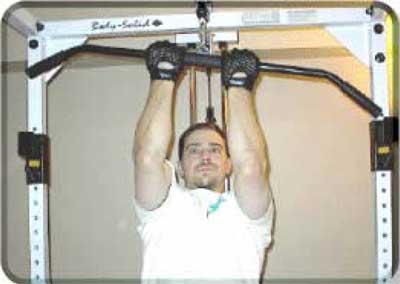Unstable Bar Chin-Ups

Why Is This Exercise So Effective?
This exercise takes advantage of the body’s response to working in an unstable environment. That response is to fire many more muscle fibers and to utilize stabilizing muscles.
When you combine this increased muscle fiber activation with the chin-up movement, you get a far more effective chin-up movement.
How To Do It

- These are done with a straight bar resting on top of a chin- up bar (a short bar is easier to handle, e.g. an E-Z curl bar, but any bar will work). The straight bar should be placed perpendicular on top of the chin-up bar.
- Grip the straight bar with your hands right up close and pinching in on the chin-up bar. This will prevent the bar from sliding around. The instability of this setup will increase the neuromuscular activity of the exercise.
- You may pull up to either side of the bar (alternate sides if you do). This will focus on one side at a time.
- You may also do the pull up directly under the bar so that you must lean back as you come up. Touch your nose to the chin-up bar on each rep. This technique will actually force you to use proper form (leaning back at the top).
How to incorporate this exercise into your workouts:
The unstable bar chin-up is a good candidate for early placement in your workouts as it requires stabilization during the movement.
- Exercises which require stabilization are more demanding and require more skill to execute.
- These types of exercises should be placed early in the routine.
- This one is not so critical, however, as you are hanging from something rather than supporting a weight on your back.
- You won’t hurt yourself if you have to drop off a bar like you might if you fall over while doing one- legged squats.
Common Errors
1. Improper body position
Keep your back arched and lean back when you do this exercise. This is the best position for working the lats. They will not be activated as well if your body is straight.
2. Not keeping hands beside bar
You must keep your hands pressed up against the chin-up bar to keep the bar you’re gripping (the one balanced on the chin-up bar) from sliding around.
Tricks
1. Pulldown bar chins
Pulldown bar chin-ups are another variation of the unstable bar chin-up. They can be done with any grip using any bar.
- Set the weight on the pulldown machine to something heavier than your bodyweight and do chin-ups on it.
- If you have access to a high pulley with no seat or hip pads, this will work better than a true pulldown machine. Just make sure there is enough weight on the stack to keep your bodyweight from pulling it down.
- Be aware of where the seat and hip pads are so you don’t bang into them on the way down. You may have to do a bit of a split with your legs to come down around the seat.
- The swinging and the uneven pulling will increase neuromuscular activity.

- The wider the grip you take, the more unstable it will be. You may find that you corkscrew around on this one. Go with it as the more unstable it is, the better. You may choose to return yourself to the start position between reps. You can also move around on purpose to increase the instability.
2. Forced reps
There is a good forced rep trick you can use with the pulldown bar variation.
- Use a weight only slightly greater than your bodyweight.
- When you come to a sticking point, give a strong downward yank and try to pull yourself up a little.
- The stack will lift up a little, the bar will drop a little and you will be up higher.



